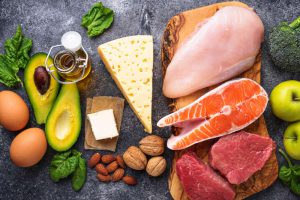Let’s start off this conversation with some facts:
- There are two types of nutrients. Macronutrients and Micronutrients
- Macronutrients are fats, protein and carbs
- Regarding macronutrients, they are all needed in correct proportions to each other. The optimal proportions for the individual are unique.
- Fat free diets are being shown to be unhealthy. For example, it is being shown in medical studies that low fat diets can contribute to hormonal imbalances.
- Hormones are made from FAT and cholesterol
Let’s shift to facts about fats specifically:
- There are two types of fat
- saturated
- unsaturated
- Saturated fats: Butter and coconut (solid at room temperature)
- Unsaturated fats come in two forms
- Monounsaturated (avocado and olive oil)
- Polyunsaturated (flax seed, walnuts, salmon)
All fats are made up of FATTY ACIDS, that come in different lengths. The body uses these three kinds of fatty acids differently. All are needed. These are the basic building blocks of body fat and all of the body’s hormones.
- Short chain
- Enter the blood stream directly from the GI track
- Take care of IMMEDIATE short term energy needs. Such as supporting the “stress response” or training in zone 4.
- Produced in the GI track by breaking down fiber (humans and animals)
- When cows eat grass (“grass fed cows”) they produce more short chain fatty acids, thus are a better source of short chain fats for human consumption. This is why beet fan butter from “grass fed cows” is a healthier choice.
- This is the preferred food for the colon and brain.
- Important for healing leaky gut
- A form of short chain fatty acids has been shown to DECREASE insulin resistance in the brain, which maybe help to positively impact Alzheimer’s
- Medium chain
- Enter the blood stream directly from the GI track
- Take care of IMMEDIATE short term energy needs. Such as supporting the “stress response” or training in zone 4.
- Long chain
- Get packaged up and stored for later use. They are not as accessible and utilize more energy in order to produce energy from them.
- Essential fatty acids. The body can produce a lot of fatty acids it needs from carbs, fiber and protein, however the essential fatty acids the body must get from nutrition.
- The consumption of Omega-6 to omega-3 should be about 4:1. However is the average diet it is about 20:1.
- Neither of these are good or bad. It is the ratio that is important.
- Omega-3 (alpha-linolenic acid)
- Hormonal impact: Fatty fish, reduce PMS
- Omega-6 (linoleic acid)
- Hormonal impact: Relieve depression and headaches
The best SOURES of DIETARY FAT:
-
Wild-caught fish
-
Pasture-raised eggs
-
Grass-fed beef
-
Extra virgin olive oil
-
Cold-pressed, unrefined coconut oil
-
Organic avocados
-
Raw, soaked nuts and seed
-
Grass-fed butter
-
Full fat cheese and yogurt
Saturated Fats
The conversation that saturated fats are needed might be new to you, as it is still very common to hear that saturated fats are bad. However, science is showing that fats are needed to support how the body is designed to work and supports hormonal health. For example, grass-fed beef is a very good source of micro and macro nutrients. Grass-fed beef has a high concentration of short chain fatty acids which the body loves, has more micronutrients as the cow is eating “real food that is nutrient dense” and much higher levels of conjugated linoleic acid. For example on the micro-nutrients, grass-fed beef has higher amounts of glutathione, which is a powerful antioxidant.
- CLA is a fatty acid found in grass-fed beef that has been shown to decrease the risk of cancer, decreasing body fat, improving insulin resistance and lowering inflammation. Studies are showing that even a small amount of CLA can reduce tumors in the body, including in the breast, colon, lungs, skin and stomach. WHOOP WHOOP.
The point to take away, red meat isn’t BAD for you. And saturated fats aren’t BAD for you. In the end, inflammation is what is making us sick. If we make cleaner food choices, inflammation goes down. Grass-fed beef is one. And we DO NEED saturated fats. That is how the body works.
Additionally, following a low fat diet makes it hard to digest and absorb fat soluble vitamins such as A, D, E and K. This can lead to deficiencies which can then lead to a host of health issues, such as hormonal imbalance issues like infertility (men and women). Saturated fats are important for the immune system and metabolism as well.
Two types of FAT to watch out for:
- Rancid Fat. Highly processed oils. Canola, soy, sunflower.
- Trans fat. High Heat. Commercial baked foods, and fried foods
Rancid fats are hard to digest and increase inflammation. (think your guts are on fire on the inside, so ALL ABSORPTION of ALL your food gets disrupted). These oils are low in micronutrients and have BHA and BHT added to them to increase shelf life. Trans fat are huge with disrupting sex hormones, disrupts with fertility (male and female) and dramatically increases inflammation.
Helpful Sources:
1. http://journal.frontiersin.org/article/10.3389/fmicb.2016.00185/full
2. http://www.sciencedirect.com/science/article/pii/S0304394016300775
3. https://www.ncbi.nlm.nih.gov/pmc/articles/PMC3770499/
4. https://www.ncbi.nlm.nih.gov/pubmed/12777162
5. https://www.ncbi.nlm.nih.gov/pubmed/6091462
6. https://www.researchgate.net/publication/20613355_Low-fat_high- fiber_diet_and_serum_estrone_sulfate_in_premenopausal_women
7. https://www.ncbi.nlm.nih.gov/pubmed/1616815
8. https://nutritionj.biomedcentral.com/articles/10.1186/1475-2891-9-10
9. https://www.ncbi.nlm.nih.gov/pubmed/16475675
10. https://www.ncbi.nlm.nih.gov/pmc/articles/PMC4462476/
11. https://hms.harvard.edu/news/trans-fats-may-raise-risk-infertility-2-9-07
12. http://journals.lww.com/greenjournal/Abstract/2007/11000/Diet_and_Lifestyle_in_the_Preventio n_of_ Ovulatory.17.aspx
13. http://ajcn.nutrition.org/content/85/1/231.full.pdf+html
